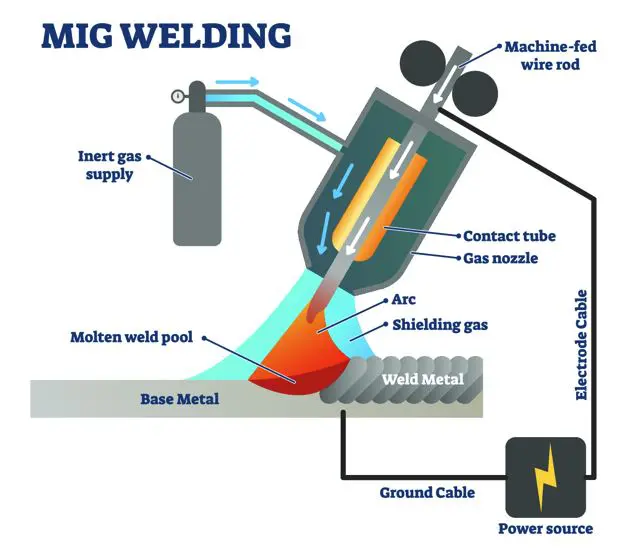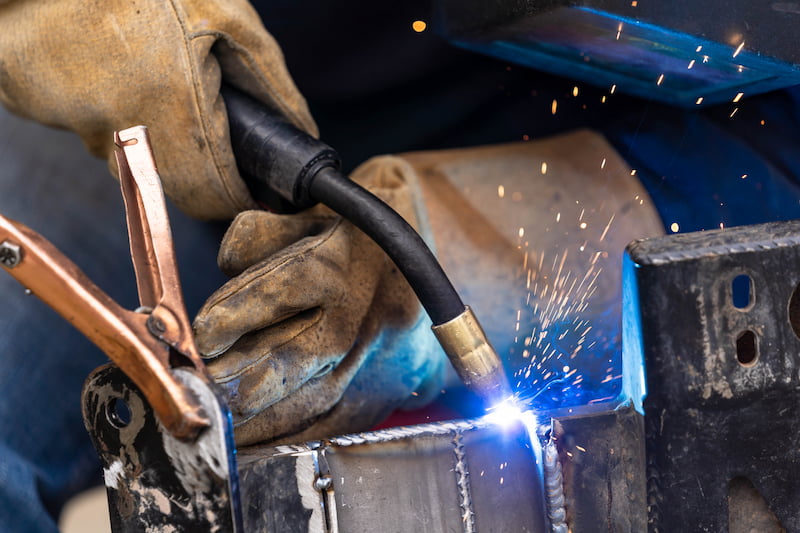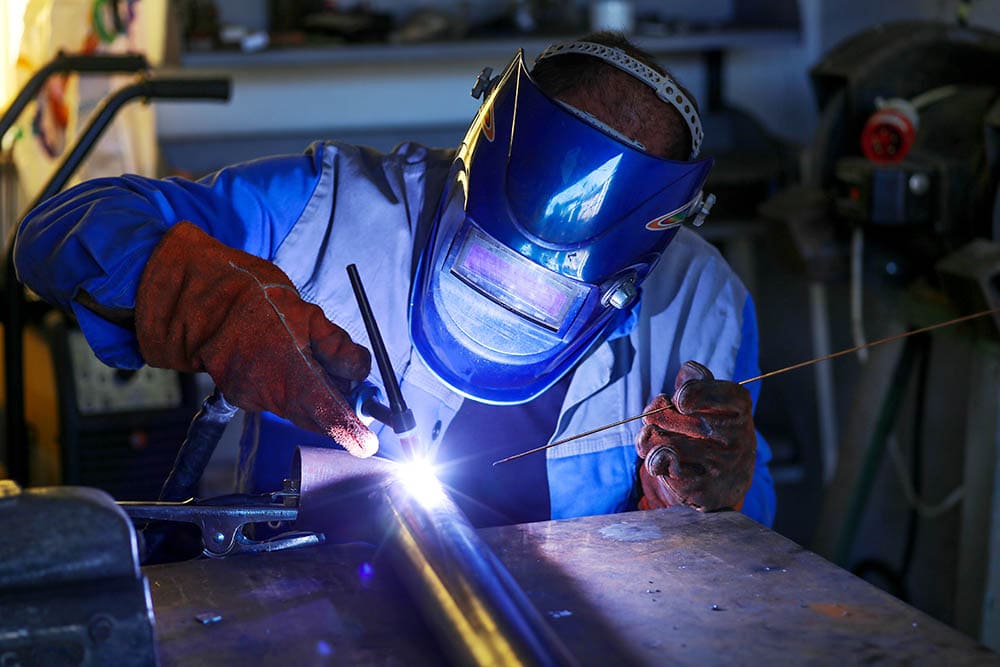One of the more popular types of welding techniques is metal inert gas welding or GMAW. Students, welders, and other professionals who are ambitious in their vocations can all profit from this procedure. Especially it is a great welding method for beginners. Why do we say that? Weldfaq‘s article will answer this question for you along with other questions like What is MIG Welding? How does it work? Uses of MIG Welding,…
What is MIG Welding?
MIG welding or Gas Metal Arc Welding (GMAW) is also known as wire welding and is one of the most common types of welding. Metal inert gas (MIG) welding is an additional name for GMAW. The weld metal can be transferred from the arc to the base metal while using MIG welding. There are a few different methods for doing this.
A consumable wire electrode is used in the arc welding process, and the welding gun supplies the junction with shielding gas. The components are melted and fused to form a solid bond by an electric arc that forms between the wire and the base metal. As for the molten weld pool, the shielding gas shields it from airborne noxious gases.

Short Circuit Transfer Methods in MIG
The most typical short-circuit transmission technique. However, the four primary metal transfer techniques available with MIG are as follows:
Short circuit: Short circuit MIG welding, which uses low voltage, is the coldest type. When the solder wire comes into contact with the metal, electricity starts to flow through the gun and shorts it out. A puddle of wet metal forms as a result, swiftly solidifying and joining the components.
Globular: The short circuit method and the bridge method are comparable. The electrode is touched by an arc that is wired to the substrate. The wire is heated for a longer period of time and with a higher heat input. Larger weld pools are produced as a result, which collect near the gun’s tip and drip into the weld.
Spray: The wire is melted into tiny droplets that are sprayed or misted into the weld in spray transmission mode. A steady stream of weld metal is sent from the arc to the base material during this constant voltage operation, which also generates a lot of heat.
Pulsed-spray: Similar to arc injection, pulsed injection transmission has been altered to remove any negative aspects. A droplet will form at the end of the wire that will be forced across the arc and into the weld puddle when the welder pulses the voltage numerous times per second. This is the most adaptable and practical transition method, but it can also be the most expensive because a top-notch MIG welder is needed.
How does MIG Welding work?
At a predetermined speed, an automatic MIG welder inserts a solid, charged wire into the weld while the provided gas shields the molten pool. The wire is powered by the internal power supply of the welder, which also controls the arc.
In GMAW, the anode of the Direct Current Electrode Positive (DCEP) is always used. That indicates that the anode is attached to the MIG torch, and the cathode is attached to the ground clamp. Pull the trigger on the MIG torch to bring the wire into the junction and create an arc. Attach the grounding clamp to the work piece. When a wire comes into contact with a grounded metal, the electrical circuit is cut off and creates an arc.
At the molten end of the arc, heat, wire, and a little amount of base metal are produced quickly. However, the wire feeder keeps forcing hard wire into the splice, resulting in yet another short circuit. The distinct splashes, sparks, and MIG sizzle sounds are caused by short circuits and tip melts, which occur many times every second.
A welder must become proficient in the correct guidance, cleaning, and optimization of voltage, flow rate, and wire feed rate in order to be effective. The weld’s quality and shape will be impacted by the welder’s travel speed. To choose the proper travel speed, MIG welders must consider how the weld puddle size relates to the joint thickness.
The gun is also simultaneously supplied with a shielding gas (often argon, carbon dioxide, or a combination) through the same supply line. The gas shields the weld pool from ambient gases that may otherwise cause the weld to become less durable. The weld is created when the heat is withdrawn because the weld puddle cools, solidifies, and creates a new piece of molten metal.

Uses of MIG Welding
In the automotive industry: Different sizes of light, heavy, tiny, or huge vehicles can be welded in by welders. Even at 0.5mm, MIG welding can create welds of high quality.
In the pipeline industry: Due to its affordability, productivity, flexibility, high-quality welds, and utilization of robots equipped with the most recent technology, it is used by the pipeline industry.
In the Railway Industry: The main application is for deteriorated surfaces on train lines. It can be challenging to weld various metal types, but the solution is to use the proper filler wire.
In the Recycling Industry: The kind of welding used for reassembling ancient vehicles or while disassembling, repairing, and rebuilding equipment. By cutting, removing, preparing new parts or joints, cleaning welds, and other techniques, GMAW welders can repair damaged automotive components.
Pros and Cons of MIG Welding
Pros of MIG Welding
- MIG welding is thought to be simpler to learn and use with one hand compared to other welding techniques.
- More welders will be more productive as a result of reducing the amount of time spent changing rods, scraping slag, and combing the weld.
- With the availability of a large array of filler wire electrode materials and the ability to weld a wide range of metals and alloys, MIG welding can be utilized to create a wide variety of welds.
- Shielding gas protects the arc during welding, which results in less slag being produced and less cleanup being needed after the task is over.
- Substantial deposit With MIG welding, “long welds” are possible, allowing you to weld larger joints with fewer passes and depositing more metal with each pass.
- When using continuously fed wire for MIG welding, you use every electrode, unlike stick welding, which often wastes some electrodes (loss of electrode stalk).
- MIG welding is excellent for plenty of DIY projects, but it’s also employed in a lot of other businesses.
Cons of MIG Welding
- A MIG welder has a relatively high initial investment cost and requires regular maintenance and part replacement.
- Because it can ignite materials that are less than 0.5 mm thick, it is not the best option for usage with some thin metals.
- Because they are not covered with slag when the weld is finished, the metal used in the weld will cool more quickly.
- The MIG welding procedure is not appropriate for outdoor use because MIG welders are not made to be portable and wind can blow away the shielding gas required to safeguard the arc.
- Vertical or overhead welding is not possible due to the fluidity of the weld pool and the high heat input of the MIG welder.
Frequently Asked Questions & Answers (Weld FAQ)
Why is MIG welding not suitable for outdoor welding?
MIG welders are not only immovable but also unsuitable for outdoor operations since they require shielding gas to maintain the quality of the weld. The shielding gas will be destroyed by wind, which will lower the weld’s quality. A MIG welder also can’t be used in the field to fix tractors, but it’s great for auto repairs in garages.
MIG vs. TIG: Which one is the best for your application?
MIG and TIG are different in terms of advantages and optimal usage cases despite the similarities between the two processes. It is substantially faster than TIG welding, which leads to shortened lead times and lower production costs. Without the necessity for cleaning and finishing, welding is also simpler to learn and develop. However, compared to TIG welding, its welds are not as exact, robust, or clean.
Typical materials used in MIG and TIG Welding operations
Both MIG and TIG welding are effective on a variety of metals, with MIG being better suited to thick materials and TIG to thin materials. Stainless steel, carbon steel, and aluminum are common welding materials.
Conclusion
What is MIG Welding? MIG welding is a particular kind of gas metal arc welding (GMAW) that is useful for joining many different kinds of metals. Many industries use MIG welding because it generates welds of excellent quality and accuracy. MIG welders are best suited for welding thin metals like aluminum or magnesium where the welder must exercise extreme process control.
Above is all about MIG Welding, hope the article is useful for you!
Maybe you want to know: 13 Must-Have Welding Tools and Accessories for Beginner

